Tea and flowers: Introduction to Chinese orchid varieties and flower pictures
Orchid species introduction and flower pictures
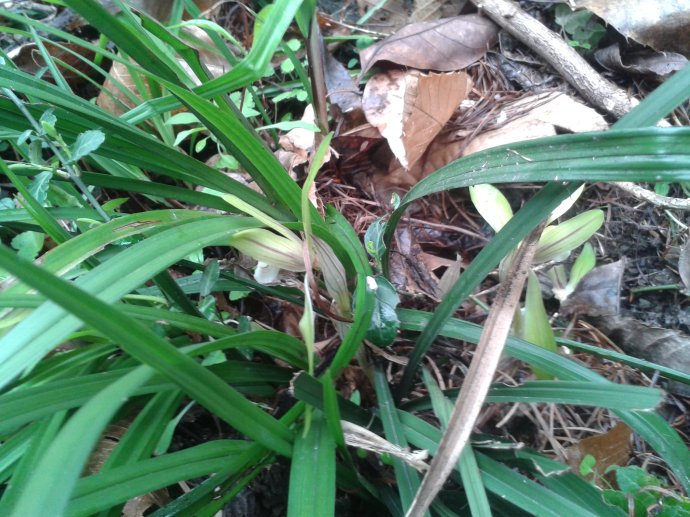
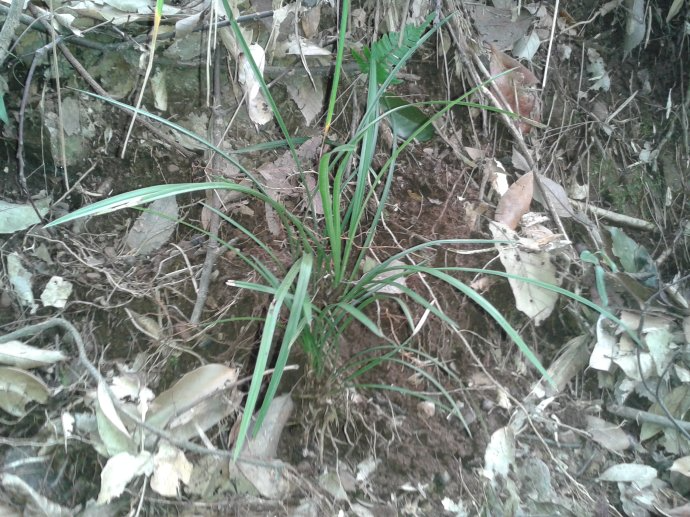
Orchids belong to the Orchidaceae family, are monocotyledonous plants, perennial herbs, and are also called orchids. Since most species of terrestrial orchids are native to the region, orchids are also called orchids. Shaoxing is the hometown of orchids. The roots are long and cylindrical, and the leaves grow in clusters from the stems. They are linear and lanceolate, with 2-3 leaves in a bunch. The roots, leaves, flowers, fruits, and seeds of orchids all have certain medicinal value. Orchids are a type of flower known for their fragrance, and are characterized by being noble and elegant.
According to incomplete statistics, there are more than 700 genera and more than 20,000 species in the world, and many new varieties are discovered and cultivated every year. Orchids are mainly divided into three categories according to their ecological habits: terrestrial orchids, aerial orchids, and saprophytic orchids. Since most varieties of terrestrial orchids are native to their native land, terrestrial orchids are also called orchids and are listed as the top ten famous flowers. Orchids are mainly divided into five categories: spring orchids, cymbidium orchids, jian orchids, cold orchids, and black orchids, with thousands of horticultural varieties.
1. Spring orchid
Spring orchid is one of the orchids with the longest cultivation history. It is described in many ancient poems and paintings. Spring orchid is also called mountain orchid, grass orchid, and ground orchid. Spring orchid blooms from February to March , and is often fragrant. The flower color varies greatly and can last for about 1 month. The leaves are relatively flat , narrow and soft. Precious varieties include lotus, plum, narcissus, butterfly and other petal shapes in various colors.
1. Song Mei
The petal type is plum petal, which was selected by Zhejiang Song Jinxuan during the Qianlong period of the Qing Dynasty, so it is also called Song Jinxuan plum. When the flower blooms in plum petal type, the three petals are particularly tight and round, with moth petals and bangs tongues ; sometimes it can also bloom in lotus-shaped narcissus petals or plum-shaped narcissus petals ; if the orchid is strong, there will occasionally be twin flowers. The old leaves are mostly arched, the bracts are light red, the leaves are dark green, the leaves are wide, and the leaf tips are blunt. It is an outstanding variety among the plum petal types of spring orchids, and is listed as the first of the four famous varieties of spring orchids.
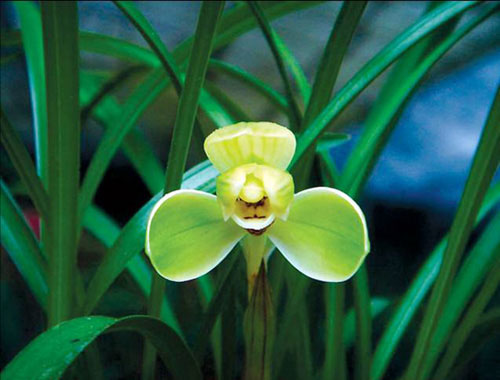
Song Mei
2. 10,000 words
It is also known as the first plum of Yuanhu Lake. It is said to have been discovered in Nanhu, Jiaxing County, Zhejiang Province during the Tongzhi period of the Qing Dynasty. It was first cultivated in the Wanjia Garden in Hangzhou. The flower is a plum petal. Because of its bright green color, transparency, fine texture, dignified and majestic charm, it gives people a relaxed and beautiful visual experience. There are very few Wanzi in stock, which is extremely rare and is indeed a genuine national orchid treasure.
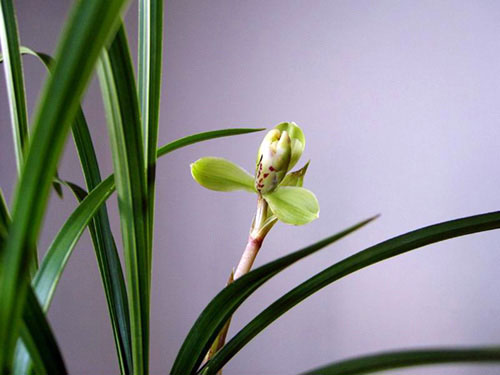
Wan Zi
3. Old Ten Yuan
Also known as " Jiyuan " . The leaves of Laoshiyuan are thick and wide, extending obliquely, giving people a beautiful line of movement in stillness. Its flowers are even more robust and dignified, with a slight yellow in green, and a few bright red patches on the small bangs, revealing a lively and beautiful temperament. The three outer petals are flat and thick, and the roots are round, looking like a miniature of a round fan. In the orchid world at home and abroad, it has always been a recognized darling and is known as the second king among the " Four Heavenly Kings " of spring orchids.
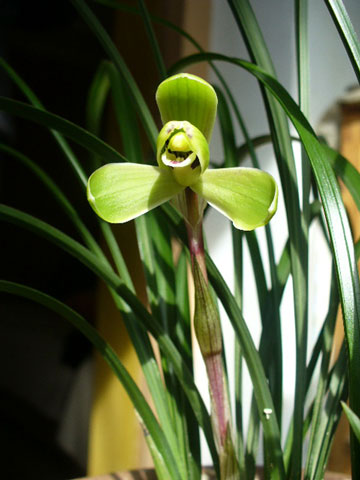
Old ten yuan
4. Wang
Selected by Wang Keming of Fenghua, Zhejiang during the reign of Emperor Kangxi of the Qing Dynasty. The flower is narcissus-shaped, with a slender peduncle, 15-20cm high, and three petals with rounded heads, tight edges , narrow roots , separate nests, soft petals , round tongues, and straight shoulders. The flower is light yellow-green, with a neat and elegant appearance. It is one of the four famous varieties of spring orchids.
The new buds are purple , the leaves are 25-35cm long and 0.9cm wide , with V- shaped grooves on the leaves , the leaves are oblique or nearly upright, green and thick, the leaves lack luster, the leaf tips are sharp, and they are very energetic. The Wangzi will not deform after a long time of blooming, and the flowers are very good.
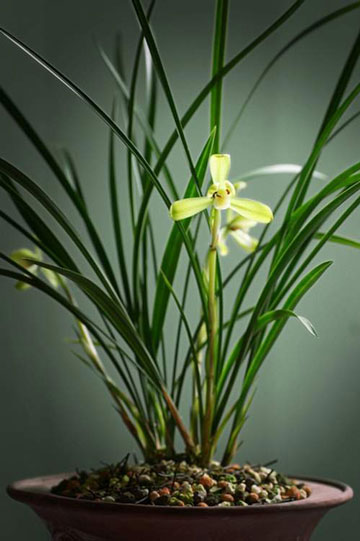
Wang
5. Other spring orchid varieties
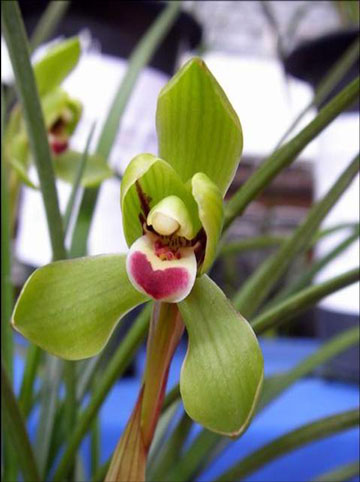
Red Lip Fairy
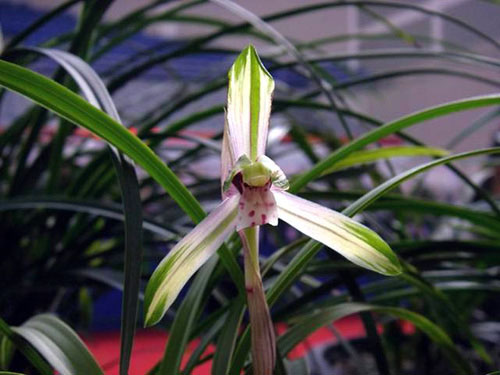
Gimcheon
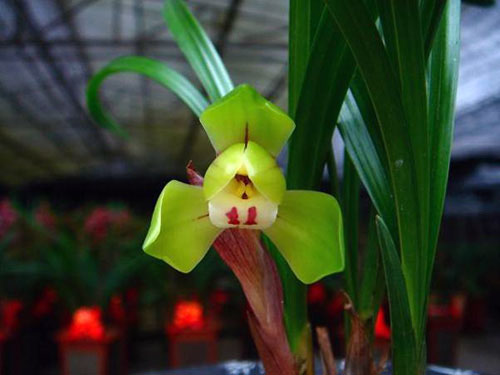
Zheng Tonghe
2. Cymbidium
Cymbidium orchid is a widely distributed terrestrial orchid, and like spring orchid, it has a long history of cultivation. Traditional cymbidium orchids are native to forests and mountainous areas. Villagers in mountainous areas call them Gaolan, Dalan, Niulan, Shanglan, etc. The ancients called one stem and nine flowers " Hui " , and " Huixin " refers to a beautiful and kind heart that unites together.
The roots of the cymbidium orchid are thick and long, and the leaves are narrow and ribbon-shaped. The texture is relatively rough and hard, pale green, with obvious serrations on the leaf margins and prominent midribs. The flowers have a strong and lasting fragrance, and the color is yellow. The flowers are mostly yellow-green or emerald green, with green velvet moss on the tongue petals, and many purple-red spots. The flowering period in the place of origin is from April to early May, and occasionally it blooms again in autumn. The distribution of cymbidium orchid is relatively wide, and it is also distributed in the north of the Qinling Mountains. The altitude of the native place is higher than that of the spring orchid, and it is relatively cold-resistant, drought-resistant, and sunny.
1. Big One
The petals of the first-class orchid are large lotus-shaped narcissus petals of green shells. According to the "Lan Yan Shu Lue", it was selected by Hu Shaomei of Jiashan, Zhejiang during the Qianlong period of the Qing Dynasty ; according to the "Lan Hui Tong Xin Lu", it was selected by Hu Shaomei in the early Jiaqing period. The first-class orchid has five petals in a nest, with a green color, firm and glutinous petals, large soft silkworm moth petals, and large Ruyi tongues. It is praised as the best lotus-shaped narcissus petals among cymbidium orchids.
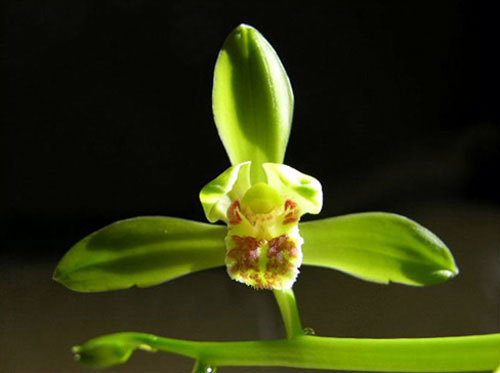
Big One
2. Fairy Green
The petals of the Fairy Green are green-shell plum petals. It was selected by orchidists in Yixing in the early years of the Republic of China. It is also known as Yixing Plum. Because the flower shape resembles the Old Shanghai Plum, it is also called the Later Shanghai Plum. The three petals of the Fairy Green are round-headed, narrow and long, with separate nests, and the center is shaped like a sheep's horn. The tongue is long and not curled. Some people often sell this variety as the Old Shanghai Plum. The bracts are green. It often blooms with plum-shaped narcissus petals.
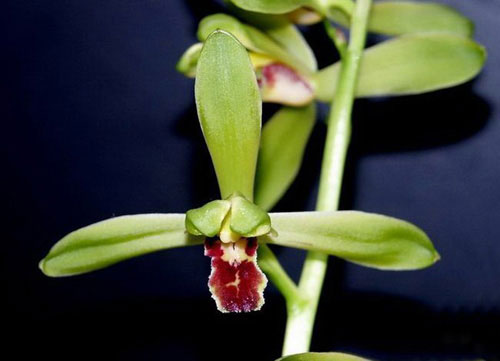
Fairy Green
3. Duan Huimei
Duanhuimei has red shell-like green flower plum petals. It was selected by Zhu Changsheng from Shaoxing, Zhejiang. The outer three petals of Duanhuimei are round, tight-edged, long-legged, flat-shouldered, half-hard-petaled, with large Ruyi tongues, regular flower shape, and slender scapes. The leaves are half-drooping.
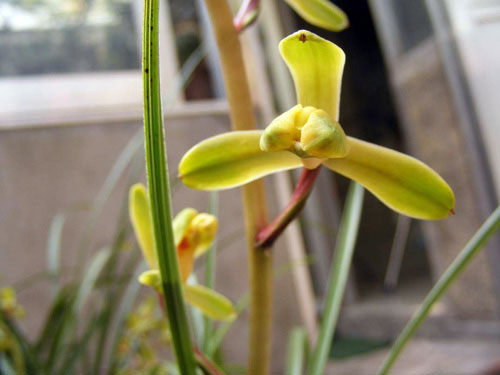
Duan Huimei
4. Cui Mei
The petal shape of Cuimei is red-green shell-like plum petal. It was selected by Cui Yiting of Hangzhou before the Anti-Japanese War. The three petals of Cuimei are round and large, with a thin base, thick and glutinous petal flesh, semi-hard center, separate nests or separate heads and backs, like a dragon swallowing a tongue. The color is green, and the shoulders are flat. It is listed as one of the new eight species and is also a famous product among cymbidium orchids.
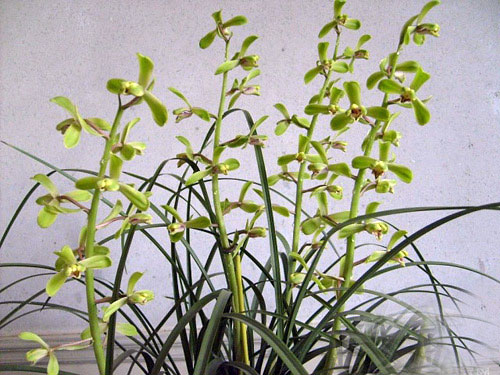
Cui Mei
3. Jianlan
Jianlan refers to orchids with main flower shape in midsummer and golden autumn, also known as four-season orchids , including summer orchids and autumn orchids that bloom in summer. Four-season orchids are strong and upright, with green leaves and abundant flowers, fragrant and beautiful flowers, not afraid of heat or cold, strong vitality, and easy to cultivate. Different varieties have different flowering periods, and flowers can be seen from May to December . There are many traditional famous varieties of Jianlan, and many new varieties have been discovered in recent years. Generally, they are divided into two categories: colored heart and plain heart.
1. Junhe
Junhe is a representative variety of lotus-petaled four-season orchids. Its petals are broad and oval, embracing the column like a clam shell. The two petals are close to each other, with the front end open to reveal the column. The color and its changes are the same as those of the sepals . The middle lobe of the lip is round and broad, hanging down but not curled, with tight and neat edges, and a small pocket at the tip.

Junhe
2. Green Light on Plum Blossoms
Also known as Shumei, it was selected and bred by Li Guangdeng from Rong County, Sichuan Province. Each plant has 3-4 leaves , and the leaves have pseudobulbs that start to spread out from the top. The plant shape is loose ; the leaves are semi-drooping ; the leaves are 23.4-38cm long , 1.1-1.3cm wide , and the leaves are emerald green. The leaf sheaths ( leaf pants ) are long and wide, dark red-green in color, and slant outward ; there are crease-like protrusions at the base of the leaves ; the leaf grooves ( the shape of the cross-section of the base of the leaves ) are deep "V" shapes ; the main vein is centered and relatively thick, and the lateral veins are fine and without filaments ; the leaf surface is flat and smooth, and traces of lateral veins can be seen on old leaves ; the leaf margins are smooth, and fine serrations can be vaguely seen at the tips of new young leaves, and the leaf tips gradually point.
The flower is a yellow plum petal, with a straight center and three petals with good rooting and angles. The petals are thick and sticky, and the stem is emerald green without any other colors, so it is called " Green Light Deng " . When in full bloom, most of them do not turn around, but face the sky. The three petals are tender green like jade, apple heads, and are quickly rooted ; they are moth sticks, smooth like jade, and dragon tongues are ready to go. The center is harmonious, and it matches the three petals of apple heads beautifully. It is a sister flower of " Yellow Light Deng Plum " .

Green light plum blossom
3. Red One
This product was collected by orchid friends Wu Yongquan and Wu Hongwei from Mingshan County, Ya'an City, Sichuan Province in Er Emei in 1993. Later, it flowed to Ya'an, Yucheng, Sichuan, and was named Jinmei by Chen Luo, chairman of the Ya'an orchid family, and Mr. Ren Guoliang. After the four- season orchid market prospered in 2004, it was named Hong Yipin by Mr. Wang Jin, a Sichuan Dujiangyan orchid family. It was promoted by Sichuan orchid families and became popular all over the world ! The leaves of Hong Yipin are 15-35cm long, 0.8-1.5cm wide , 2-4 leaves , and the heart leaf ends are mostly blunt-pointed. The leaves are half-hanging, silkworm-shaped, and wishful tongues. Each arrow has 2-6 flowers , stable petal shape, high germination rate, and easy to cultivate. The flower color is gorgeous, the flower is dignified, stretched, the petals are thick, the sepals are tight, round and rooted, the center palace is standard, the whole flower structure is firm and clever, the petals, shape, and color are excellent, and the charm is full. No matter whether the seedlings are grown in different regions and using different planting materials, they can produce standard plum petals regardless of their strength.
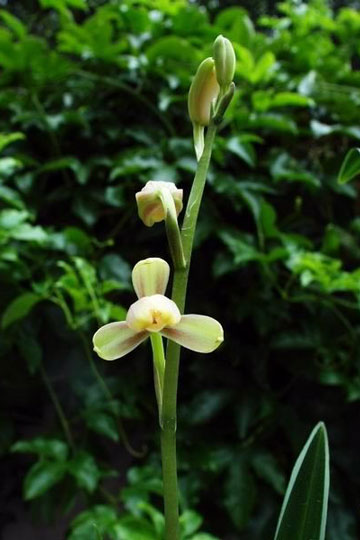
Red One
4. The Kirin of the Five Mountains
The only unique flower among the eight famous varieties of Jianlan. The green flower stem is delicate but vigorous, and the flower stands tall . The countless emerald green petals, the green and yellow nose and the deep red tongue are in sharp contrast. The upper part is the orderly arrangement of the petals and nose, while the lower part is the numerous tongues, like bright red banners . The leaves are slender, the leaf posture is neutral, and the leaf tail has a more obvious " yin and yang tail "; the reed head is round and bulging like a glass ball.
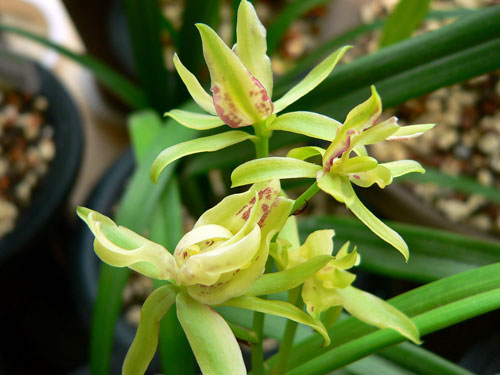
The Five Mountains
5. Other Jianlan
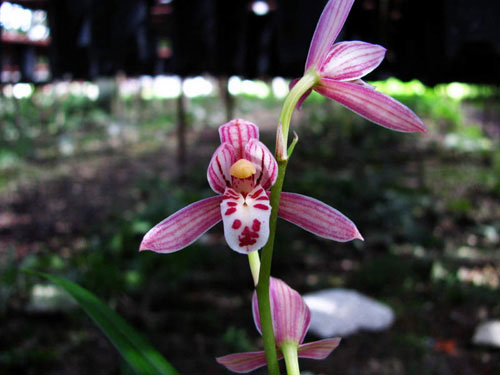
Emei Jianlan
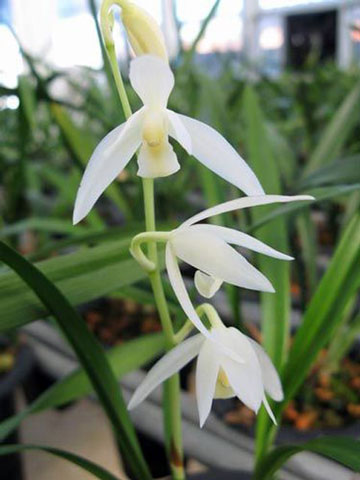
Lijiang Snow
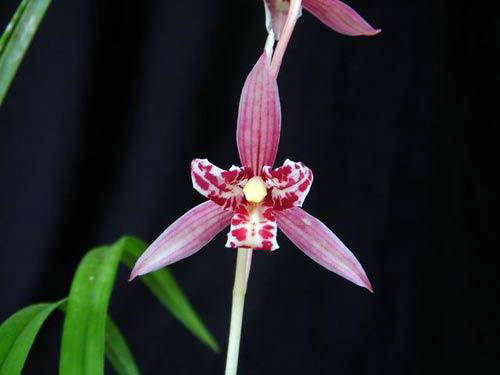
Stunning Samsung
4. Molan
Molan, also known as the orchid of the year , ...
1. Golden Mouth Molan
There are 3-5 leaves , clustered on an oval pseudobulb, the leaves are sword-shaped, dark green, and have golden tips, hence the name " golden tip " . The flower stems are upright, higher than the leaves, and the flowers are fragrant, with 7-17 flowers on each stem .
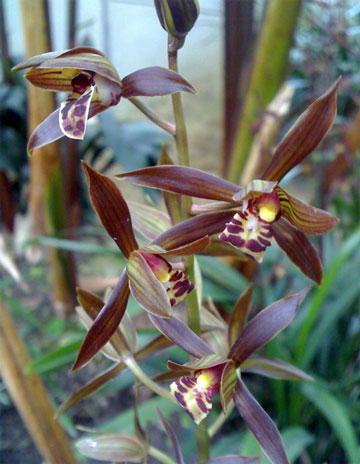
Golden Mouth Black Orchid
2. Black Molan
Qihei is also called Qijian, Shanchuan, etc. It has a compact plant shape ; the leaves are relatively upright and broad, dark green without any spots or lines ; the flowers are fragrant, the flower stems are upright and do not protrude above the leaves, and the number of flowers on each branch is generally 8-16 .
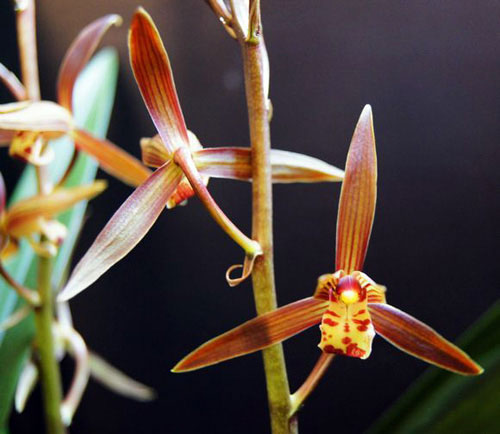
Black Molan
3. Qijian Baimo
Baimo is one of the four traditional varieties of Molan. Its pseudobulb is large and oval . Its leaves are long and slightly drooping, dark green . Its flowers are jade white, fragrant, and high branches, with 7-17 flowers on each branch. Qijian Baimo is known as " the black one is not white, the white one is not black, the black one is in name, the white one is in reality, the black one can be white, others are turbid while I am clear " , from which we can understand the meaning of " those who are close to vermilion are red, those who are close to ink are black " .
In the book "Linghai Lanyan" written by Qu Jince in the late Qing Dynasty, it is said: " Our Guangdong is the best in the world with its white ink. The flowers must be outstanding, the leaves must be bright and moist, and the fragrance must be quiet and far-reaching. These are the three unique features . "
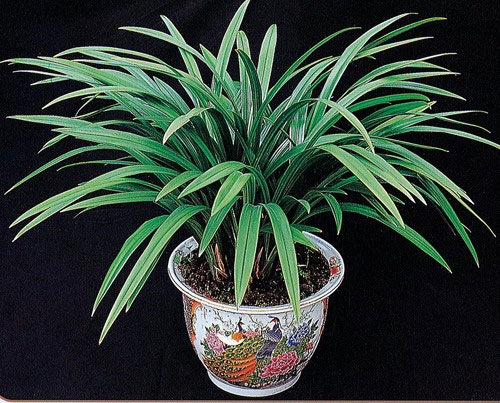
Qijian Baimo
4. Shenzhou Qi
Shenzhouqi is produced by Chen Qixiong of Shunde. The plant is 45-47 
Shenzhou Qi
5. Lotus and Butterfly in Huaxi
Cultivated and named by He Jianguo from Shunde, it is a rare black orchid with dark green leaves, 5 to 10 flowers , butterfly flowers, red with yellow, broad sepals, and drooping lip with a large red spot.
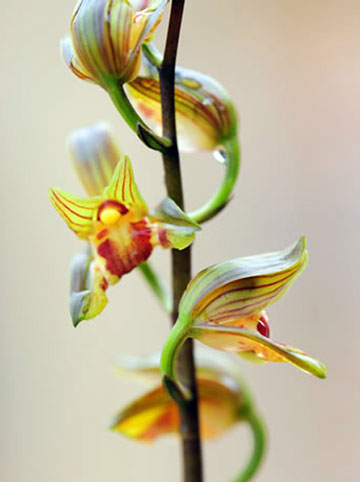
Lotus butterfly in Huaxi